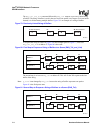
Hardware Reference Manual 211
Intel
®
IXP2800 Network Processor
SRAM Interface
A side-effect of the pipeline registers is to add latency to reads, and the SRAM controller must
account for that delay by waiting extra cycles (relative to no external pipeline registers) before it
registers the read data. The number of extra pipeline delays is programmed in
SRAM_Control[Pipeline].
6.4 Command Overview
This section will give an overview of the SRAM commands and their operation. The details will be
given later in the document. Memory reference ordering will be specified along with the detailed
command operation.
6.4.1 Basic Read/Write Commands
The basic read and write commands will transfer from 1 – 16 longwords of data to or from the
QDR SRAM external to the IXP2800 Network Processor.
For a read command, the SRAM is read and the data placed on the Push bus, one longword at a
time. The command source (for example, the Microengine) is signaled that the command is
complete during the last data phase of the push bus transfer.
For a write command, the data is first pulled from the source, then written to the SRAM in
consecutive SRAM cycles. The command source is signaled that the command is complete during
the last data phase of the pull bus transfer.
If a read operation stalls due to the pull-data FIFO filling, any concurrent write operation that is in
progress to the same address is temporarily stopped. This technique results in atomic data reads.
6.4.2 Atomic Operations
The SRAM Controller does read-modify-writes for the atomic operations, and the pre-modified
data can be returned if desired. Other (non-atomic) readers and writers can access the addressed
location between the read and write portions of the read-modify-write. Table 72 describes the
atomic operations supported by the SRAM Controller.
Figure 76. External Pipeline Registers Block Diagram
A9735-01
Q
Addr, BWE, etc.
SRAM SRAM
Intel
®
IXP2800
Network
Processor
Register
Register


















